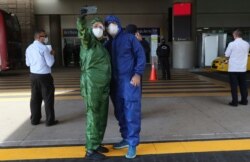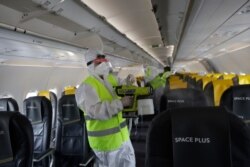Mammoth rescue packages for some airlines are proving to be not enough. Major companies plan to cut jobs as they struggle to cope with a plunge in air travel that will leave the airline industry much smaller than it was before the coronavirus pandemic hit and has dealt a shock to the global economy.
American and United Airlines plan to cut 30 percent of their management and support staff. Delta Air Lines said it will extend early retirement and buyout offers in a bid to limit layoffs in the fall.
“While we never dreamed just a few months ago that we would be talking about a smaller Delta … this is the reality we’re facing,” CEO Ed Bastian said in a memo to employees.
These actions aren’t surprising, said transportation expert Cliff Winston, a senior fellow at Brookings Institution. “Let’s bear in mind that the job of the airlines is to make efficient use of their resources. There’s really no point if they are not flying the routes they once flew, they’ve obviously cut back their coverage. At the same time demand for their services is dramatically down. So they need a lot less labor.”
Volodymyr Bilotkach, author of The Economics of Airlines said 30 percent is a big number but said the workforce has grown bigger than the number of travelers in the past five years.
“Over the last five years, actually, the U.S. airline industry added about 25 percent of their workforce. So from 600,000 in March 2015 to around 750,000 in March 2020.” And at the same time looking at the passenger numbers, “they have increased by a bit more than 15 percent,” he points out.
He said he understands that profit margins for airlines are slim and that there are still lots of unknowns but he’s surprised at the layoffs some airlines plan to carry out given the rescue packages they recently got from the government.
Under the Payroll Support Program created through the Coronavirus Aid, Relief, and Economic Security (CARES) Act, companies such as American Airlines will receive $5.8 billion in financial assistance, including grants and low-interest loans; United Airlines, approximately $5 billion; Delta Air Lines, $5.4 billion; and Southwest, $3.3 billion. Other airlines are benefiting from the rescue packages as well.
In a statement, American Airlines said that while the CARES Act money helped, the company needed to reduce its cost structure given it will be flying some 100 fewer planes in the summer than originally planned. American said this means it will need a leaner management and support staff team.Around the world, airlines have grounded about 15,000 jets – more than half the global fleet – and pressed some planes into cargo duty to bring in revenue.
In Addis Ababa, Ethiopian Airlines engineers were recently busy transforming some of their planes.
"We have been converting passenger aircrafts to cargo aircrafts. We have converted 20 of them; it depends on the fleet, but it took 36 hours and less," said Rekik Tsegaye, a cabin maintenance technician at the company.
Ethiopian Airlines recorded a loss of $550 million between January and April, but company CEO Tewolde GebreMariam said he’s optimistic.
"We see some kind of maybe 50 percent recovery in the summer, because it is a summer peak. And we see that people are sick and tired of the lockdown, as you can see in Europe and America governments are opening, even people are also going out because people were not meant to be locked down."
It might be hard for other African airlines to survive. Some had been piling on debt long before the pandemic, but government bailouts allowed them to limp on for years.
EasyJet, the London-based budget airline is also making cuts -- up to one-third of its 15,000 employees.
CEO Johan Lundgren said the carrier plans to resume limited service on June 15 but estimates that it may take three years to get back to 2019 demand levels.
Several major airlines have filed for bankruptcy protection, including South African Airways, Virgin Australia and the two largest carriers in Latin America, Latam and Avianca. This underscores the severity of the financial challenges facing the travel industry as a result of the lockdowns, quarantines and other measures taken by governments. But this may not necessarily be a death sentence, Winston said.
“They just want a timeout. They want a chance to reorganize, try to get their finances in order. They'll have their creditors now wait and not have to get paid … they want to forestall liquidation.”
Winston said when transportation is cut, there are reverberating effects, and activities of all sorts, whether they’re job-related, leisure or technology, are affected in subtle ways.
He said policymakers need to take the long view and say to themselves “we want to keep the transportation system as a vital service … we obviously want the economy to come back, but we need to think in the long term how to make the industry as efficient as possible and as robust to these kinds of shocks as possible.”
As the pandemic lockdown eases, experts say airline recovery will depend on many factors – especially on passenger confidence that they can fly again.











